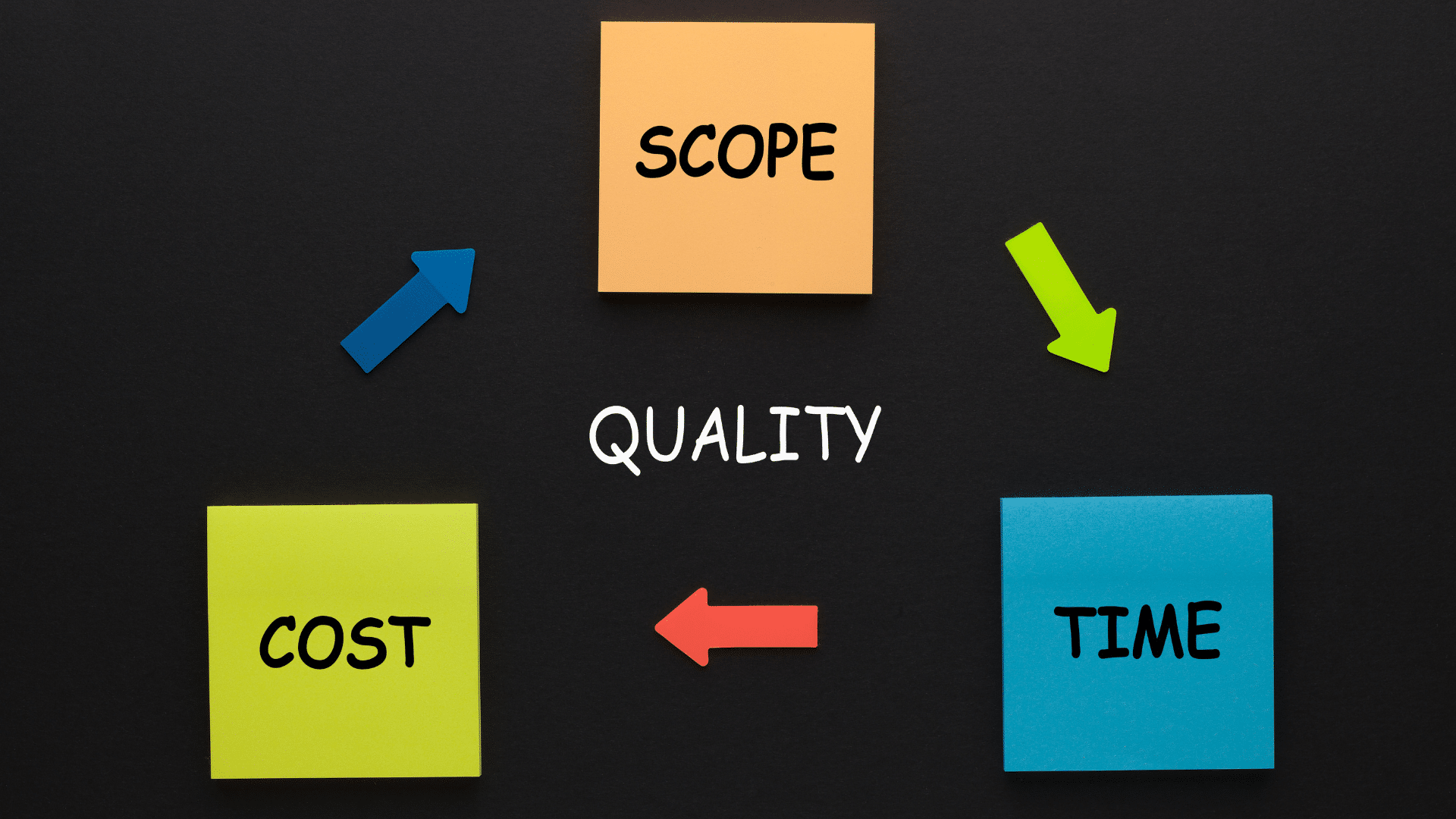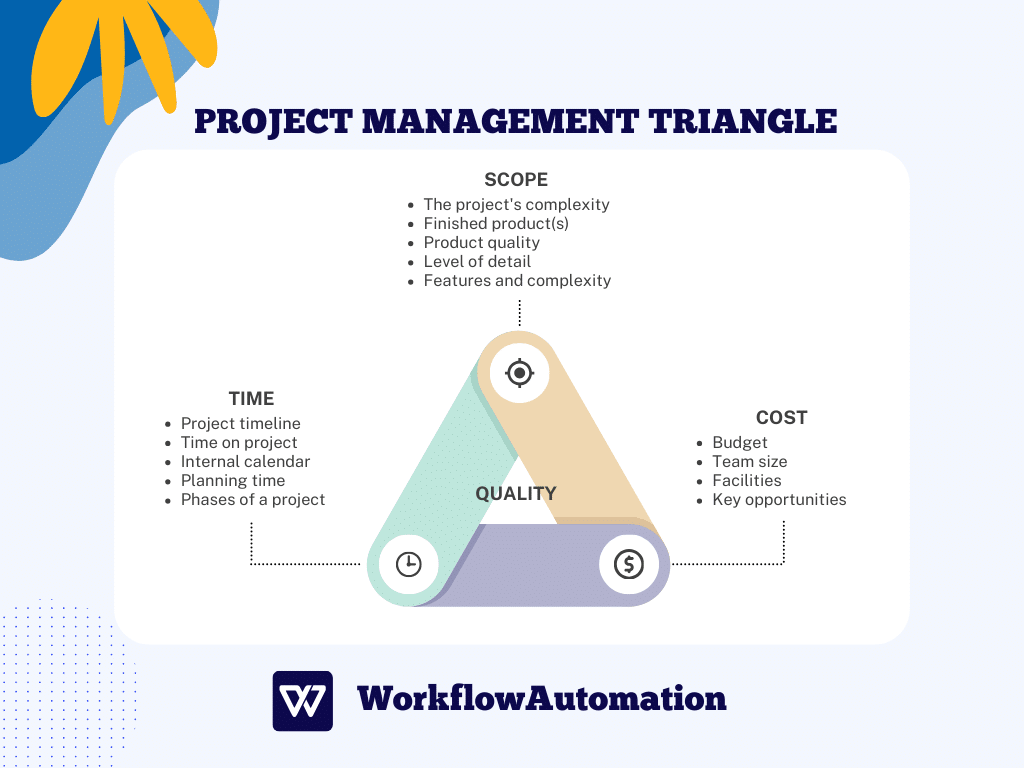The project management triangle—scope, time, and cost—weaves its way through the entire project journey, much like family, work, and friends do in life. There’s hardly a project without tasks, a clear goal, a set timeframe, and a budget to make it happen.
This analogy serves as a starting point, a reminder that projects, much like life, rely on a delicate balance of key elements. Just as we navigate the complexities of our personal and professional worlds, the success of a project hinges on the harmonious interaction of scope, time, and costs.
Let’s delve deeper into the concept of the project management triangle, its importance, and practical strategies to manage it.
What is the Project Management Triangle?
The project management triangle (also known as the triple constraint triangle) is a fundamental model in project management.
This model holds significant importance in project management as it visually illustrates the interdependence of three essential elements: cost, scope, and time. It showcases how these factors are intricately linked and how a change in one aspect can affect others and the entire project.
While the precise origins of the project management triangle remain a topic of historical debate, it’s most commonly associated with Dr. Martin Barnes in 1969, who originally represented the time, cost, and quality triangle. Some also attribute its development to Eliyahu M. Goldratt’s Theory of Constraints, introduced in 1950.
However, in the project management triangle, each corner represents one of the constraints, while the triangle’s sides depict the relationships between them. Now, let’s delve deeper into the significance of each factor and explore how they influence one another.
#1. Cost
From the start of the project phase and throughout its execution, the available funds for managing a project play a crucial role. These funds are essential to initiate and sustain the project until its completion.
It is necessary to carefully estimate the expenses for all inputs required to produce the project’s desired output, including any unforeseen costs that can arise due to potential risks and unexpected changes. It refers to the following components:
- Procurement costs: Procurement costs pertain to the expenses incurred for acquiring materials and obtaining the required tools or services.
- Labor costs: Just as materials and machinery are essential for generating a specific outcome, the human factor is equally vital to managing those resources effectively.
- Contingency costs: To avoid project delays caused by recognized risks or unforeseen circumstances, reserve funds for unexpected situations. Setting aside extra money in the budget prepares you for any unexpected challenges that might come during the project.
#2. Scope
Successfully managing the scope involves detailed planning of tasks, timelines, and project deliverables and addressing the involvement of all stakeholders while adapting to changes and proper documentation.
Here are a few examples of project management triangle scope:
- Clear roles and responsibilities: Communicate with your team and clearly define the tasks expected from each member, the desired quality of outcomes, deadlines, and expectations. This approach ensures that everyone comprehends their responsibilities and parts.
- Change requests: Be cautious to avoid falling into scope creep, where demands increase with sufficient time or resources for their execution. In such cases, balance the workload through the change management process and prioritization of tasks.
- Stakeholder expectations: Actively involve stakeholders in defining the project scope and consistently keep them informed about the progress to ensure that you meet their expectations.
#3. Time
In the project management triangle, the time factor refers to the timeframe you need to complete the project.
This involves determining and strategically managing the duration of project phases and achieving milestones within the planned time. It also includes ensuring the availability of the workforce within the project.
To effectively manage this component, here’s what you should keep in mind:
- Critical path delays: Create a critical path and closely monitor activities that significantly influence the project timeline. Identify potential delays and address them proactively.
- Resource allocation: Ensure proper utilization of resources to avoid disruptions due to inadequate management. Doing this involves adjusting the scope or budget, such as allocating funds to hire an additional workforce to complete the job or investing in process automation.
- Time-to-market: Stay attuned to market demands and align your project accordingly. Meet market expectations by either expediting timelines or engaging experts to ensure a successful outcome.
The Importance of Project Management Triangle
After gaining insight into the project management triangle and its role, let’s explore the significance of effectively managing its three key segments.
#1. It Helps Mitigate Risks
The project management triangle acts as a guide to avoiding risk and bottlenecks. By understanding how scope, time, and cost are connected, project managers can spot challenges and take action to prevent issues.
For example, if the client asks for more features, the project manager can see how it affects time and cost and make adjustments to keep everything on track.
#2. It Helps With Prioritization
In a complex project, setting priorities is essential. The project management triangle helps in making intelligent decisions when priorities conflict. For instance, the scope might need adjustments if the project must finish quickly. On the other hand, if the client wants an extensive scope, more resources can be allocated, possibly extending the project timeline.
Using the project management triangle can help to understand which moves you should make first to achieve optimal prioritization.
#3. It Allows Easier Change Management
Change is standard in projects, but managing it can be challenging. The project management triangle helps deal with change more efficiently. When a change is requested, project managers can assess its impact on all three elements.
This way, they can communicate the effects of the change to everyone involved and make informed decisions. For example, clients can be informed in advance if a change delays the project, managing their expectations.
#4. It Improves Communication With the Client
The project management triangle helps explain project constraints to clients visually. Project managers can show how changes affect the other elements when discussing potential adjustments, like adding more work or speeding up the project’s progress.
This way, clients can make informed choices, and stakeholder teamwork becomes more productive.
5 Strategies for Managing Project Management Triangle
Let’s discuss five strategies project managers can implement to manage the triangle efficiently and deliver successful projects.
#1. Set Clear Expectations
This strategy ensures that each participant in the project has expectations that align with the project’s vision. Achieve it by ensuring you communicate on all levels about the specific project’s purpose, intended outcome, and boundaries—clarifying what is within the project scope.
The ultimate goal is to establish clear and defined goals and a shared understanding of the project’s purpose and the objectives it aims to achieve.
By openly communicating and aligning everyone’s expectations, we increase the likelihood of completing the project with satisfying results. When being transparent about the project’s goals and limitations, we prevent misunderstandings and conflicts.
To set clear expectations, project managers should communicate with stakeholders, including clients, team members, and sponsors. Information channels need to be open and transparent throughout the project’s implementation.
Therefore, regularly disseminate project updates and progress reports to the stakeholders and meticulously document all requirements, expectations, and agreements.
#2. Establish Priorities
To avoid getting lost in the multitude of tasks and questions that await a project, it’s essential to proactively determine the most crucial tasks that demand attention and monitoring. These critical tasks, often called milestones, represent significant events or aspects that profoundly impact the project’s progress.
Establishing priorities is paramount as it shifts the focus onto critical moments in the project. By identifying these pivotal points, successful project completion largely depends on their timely and high-quality execution.
Monitoring them increases the likelihood of meeting deadlines and delivering outcomes efficiently, preventing unnecessary resource allocation to less critical events that can be easier to handle if they occur.
Determining priorities involves effective communication with stakeholders to understand their needs and interests. You can facilitate it using various communication apps or meeting agendas, which aid in addressing priority tasks more efficiently. This way, you can tailor strategies to the stakeholders’ expectations and ensure successful outcomes.
#3. Create a Risk Management Plan
Creating a risk management plan involves identifying and dealing with any possible events affecting the project, such as scope creep, schedule delays, or cost overruns. Analyzing these potential events helps us recognize them early and take action to prevent their negative impact on the project.
Developing a risk management plan is critical for ensuring a smooth workflow within an organization. With a well-prepared plan, the organization can more effectively navigate risky situations and respond promptly to mitigate potential damages.
The risk management process involves several key steps. Initially, the project team engages in brainstorming sessions and examines historical data from similar projects to identify all possible risks.
Next, these risks are assessed based on their probability of occurrence and the potential impact on the project. Finally, the team devises risk mitigation strategies integrated into the project plan.
#4. Create a Change Management Plan
A change management plan is essential in project management because projects are dynamic, and we expect modifications to the original plan over time. A change management plan can turn these modifications into favorable outcomes for the organization, clients, external factors, and other project participants.
By creating a change management plan, an organization acknowledges the inevitability of changes during project execution. By anticipating and proactively managing these changes, they can minimize any negative impact on the organization.
A change management plan should outline potential areas where deviations from the original plan might occur and define strategies to align those deviations with the organization’s goals without disrupting the project’s stability.
#5. Adjust PM Methodology Based on Constraints
Adjusting the project management methodology means tailoring the project’s approach to meet its specific requirements and limitations. For each project, defining the most suitable structure and organization is essential to ensure efficiency.
For instance, Agile methodologies, like Scrum, are well-suited for projects evolving requirements and incremental value delivery. At the same time, the waterfall approach can be more suitable for projects with stable and well-defined conditions.
This is crucial because the project’s success depends on selecting the proper methodology. Poor choices could lead to chaos, inconsistent operations, missed deadlines, and low-quality outcomes.
After identifying the suitable methodology, we implement it through training and workshops. Involving specialists can facilitate the transition, particularly when building upon existing practices. It is crucial to encourage open communication and feedback throughout the process to prevent employee resistance and avoid low productivity and subpar outcomes.
Conclusion
In any project, success hinges on how well the trio of scope, time, and cost work together. So, to ensure a seamless coordination of these three elements, project managers take the helm.
They set the path and outcomes, then guide their team and stakeholders in sync with the project’s scope, the available time, and the allocated budget.
With this strategic insight, you can ensure everyone shares the same understanding of the project while also adhering to the timeline and budget management, which will lead your project to success.
It’s a recipe for success and a basic rule that applies to all projects, big or small!
Project Management Triangle FAQ
#1. What are the three sides of the project management triangle?
The three sides of the project management triangle are scope, time, and cost.
#2. What causes scope creep in project management?
Scope creep in project management is caused by continuous or uncontrolled expansion of project requirements, deliverables, or objectives without corresponding adjustments to time and resources. It leads to a larger project scope, impacting the timeline and budget.
#3. What is an agile iron triangle?
The Agile iron triangle is a variation of the traditional project management triangle, which includes flexibility, quality, and speed as its three sides.
#4. How does the project management triangle work?
The project management triangle works by illustrating the relationship between scope, time, and cost. If one of these aspects changes during the project, the other two are affected.







